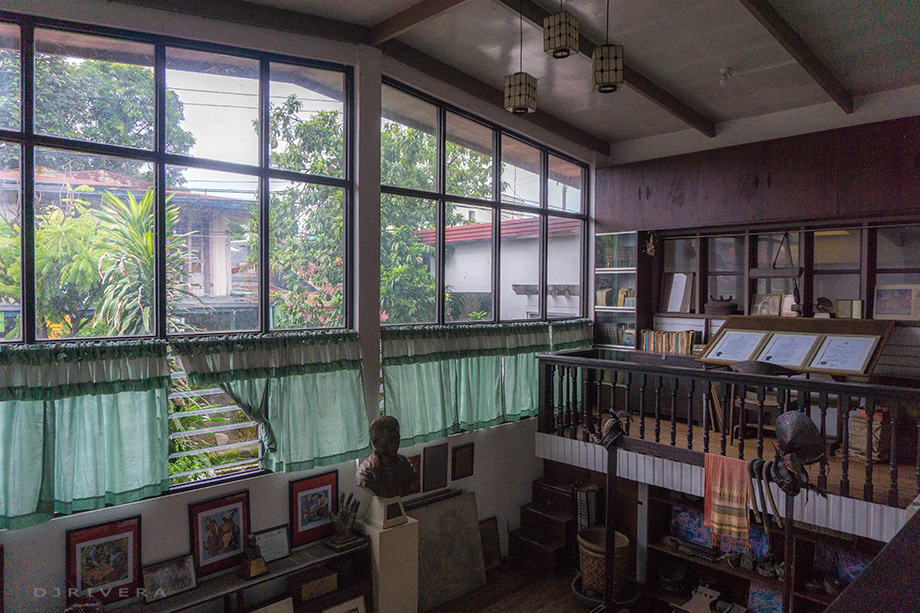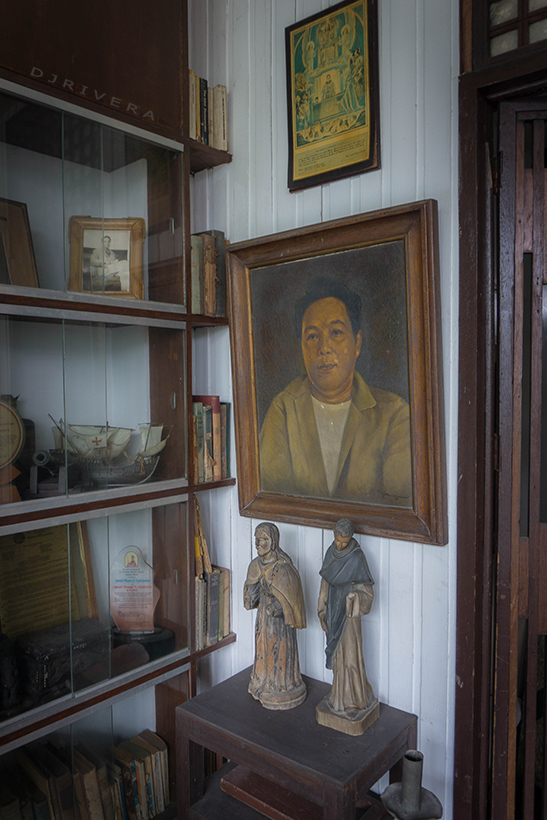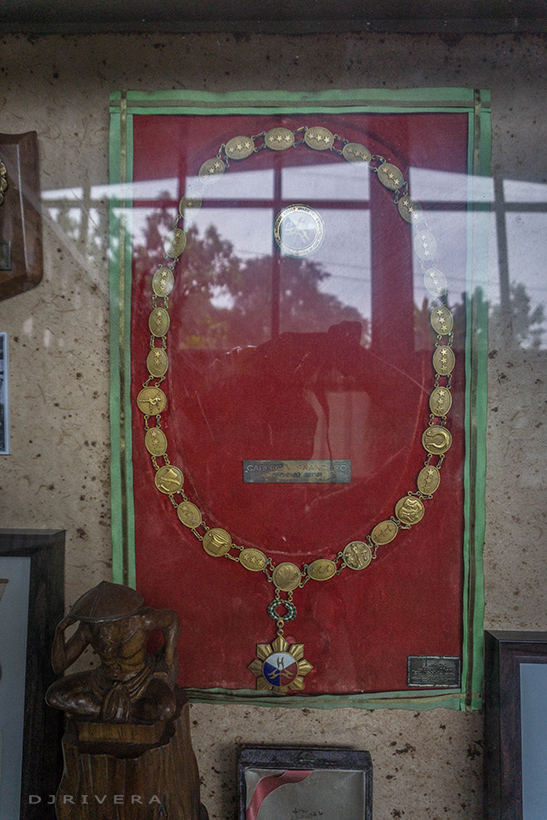 |
Owing to the mural sculptures flanking its cobbled walkway, Angono’s Doña Aurora Street is an eye-catching thoroughfare. The street’s array of concrete reliefs on residential fences, chiseled by the town’s homegrown artists, depicts the paintings of Botong Francisco, Angono’s illustrious son who himself resided along the avenue. In his house that also became his studio, he brought into existence works of art that bear paramount importance to the Filipino culture and from which younger artists and citizens of his hometown find inspiration and pride.
 |
| One of Angono's street murals is inside the gates of Botong Francisco's house |
Carlos Modesto “Botong" V. Francisco
Botong was born in November 4, 1912. A known muralist and an Angono native, his subjects encompassed scenes from daily life and folk customs of his suburban hometown, unique Filipino traditions, and significant events in Philippine history. His large-scale, mostly commissioned artworks adorn government buildings, corporate headquarters, universities, and private and public museums.
 |
| Botong Francisco's "Bayanihan" displayed inside the house |
His most prominent works belong to the roster of National Cultural Treasures. The “Filipino Struggles through History”, a series of paintings commissioned by the Manila city government in 1960s, depicts selected historical events from the pre-colonial Kingdom of Tondo until the Philippine Independence in 1946. Portrayed in “The Progress of Medicine”, a four-panel painting commissioned for Philippine General Hospital (PGH), is the chronology of healing practices from pre-colonial Philippines up to the modern medicine. The National Museum of Fine Arts took over the upkeep of these cultural gems to avoid further deterioration and make them more accessible to the public, providing in turn more durable replicas for the “unfriendly” environs of their first homes in Manila City Hall and PGH.
Botong’s artistry also reached the realm of Philippine cinema. He partnered with Manuel Conde, filmmaker and fellow National Artist, and their duo produced Genghis Khan in 1952. Though operated on a shoestring budget, the film gained a spot in history by becoming the very first Filipino motion picture to enter the world stage through the prestigious Venice Film Festival. Botong took part in research, some writing, and the film’s production design.
 |
| Botong in Rover Scout uniform (second to the left) |
Aside from his valuable artworks, Botong, also an active Rover Scout, was known for yet another cultural treasure, the Angono Pertroglyphs—ancient artistic carvings on rock formations situated in the mountainous municipal borders of Angono and Binangonan—which he discovered during a field trip with the boy scouts.
Botong died in March 31, 1969 leaving a rich legacy not only to his hometown known today as the country’s art capital but also to the Filipino identity. His remains lie in Angono of his birth. In 1973, he was elevated posthumously to the Order of National Artists. In 2002, his second cousin and close friend, kababayan, and fellow National Artist Lucio San Pedro was interred beside his tomb.
READ ALSO: Blanco Family Museum: Vast Exhibit by a Family of Visual Artists
 |
The House and Studio of Botong Francisco
According to Totong Francisco, Botong’s grandson who manages the house-turned-museum, the ancestral structure is 90 percent original. Some renovations were undertaken before his lola opened the house to the public in 1970s, at the time the family received Botong’s posthumous National Artist conferment.
 |
 |
The silong of the bi-level Francisco residence used to be the atelier that gave birth to Botong’s obras maestras. Within the corners of the house, one can find Botong’s memorabilia on display—his garments and some trinkets, his palette boards, drawing table, shabby wooden chair and easel, and various token of recognitions he received during his lifetime and thereafter. The library on the upper floor holds pieces of antiquarian books. Mounted on the walls is a paradox of the black-and-white photographs visually telling Botong’s life and the vivid replicas of his notable paintings.
READ ALSO: Nunelucio Alvarado and Sagay City's Vibrant Art Scene
 |
| Totong Franciso (in blue) entertaining house visitors |
 |
| Portrait of Botong Francisco |
 |
| Some of Botong's old photographs |
 |
| Botong's National Artist medal |
The exhibit is not that huge, but it’s more than meets the eye. Totong has background stories behind every piece on display; such stories serve as window to Botong’s colorful life and give guests an engaging tour around the National Artist’s abode.
Totong Francisco’s The Second Gallery
Carlos Francisco II, or Totong, did not only inherit the name but also his lolo‘s love for painting. Botong aside, Totong’s the only member of the Francisco household to carve out a career from painting. Like his lolo, he takes on commissioned work but he also paints to merely express himself. His works incline to abstractionism.
 |
| Totong Francsisco's "Metamorphosis" |
 |
| Totong Francisco's "Fragments of Nature I" |
 |
| Smudge of acrylic from one of Totong's works |
 |
| Inside The Second Gallery |
Beside the familial house, on a former garage, is Totong’s own showroom “The Second Gallery” where his works are on display for house visitors to behold and for art collectors to swing by and make a purchase.
 |
| The author with Totong Francisco |
How to Get to Botong Francisco's House-Studio
Address: Doña Aurora St., Brgy. Poblacion Itaas, Angono, Rizal
Drive: https://waze.com/ul/hwdw4suh2p (using Waze app)
Commute: Take Angono-bound jeepney or UV Express at the terminals in Mandaluyong (at SM Megamall, Robinsons Galleria, Starmall EDSA Shaw or Greenfield District) or at terminals near Marcos Highway in Pasig (at Sta. Lucia East Grandmall or Robinsons Metro East) then alight at Doña Aurora Street (located just before Angono Public Market). Landmark: busts of Carlos Francisco and Lucio San Pedro at the street’s welcome arch.
Fee(s): FREE
Contact(s): Botong Francisco Studio/The Second Gallery (Facebook page)


